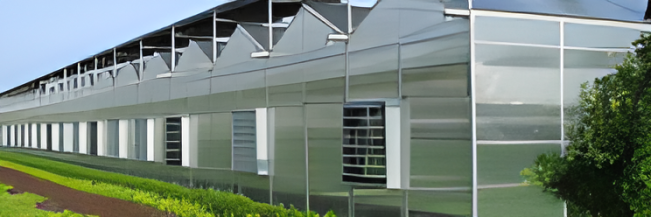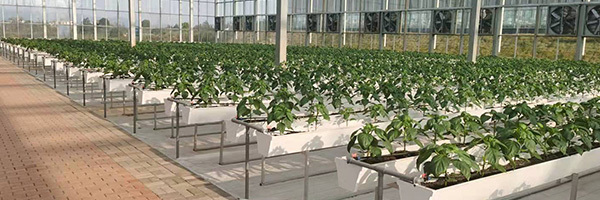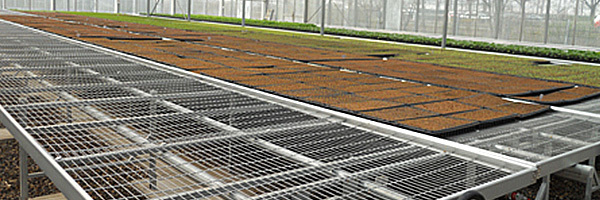-
-
Company Profile
-

Greenhouse Structures

-
Polycarbonate sheet greenhouse
-
Glass greenhouses
-
Multi-Span film greenhouse
-
Tunnel greenhouse
-
Sightseeing greenhouse
-
Double-film frame solar greenhouses
-
Glass and polycarbonate sheet greenhouses
-
Glass greenhouses structures suitable for planting
-
Glass Greenhouse for Scientific Research
View More -
-

-

Enhancing Eco-Friendliness with Glass and Polycarbonate Greenhouses: The Sustainable Future of Agriculture
Release time:
2025-10-04
Enhancing Eco-Friendliness with Glass and Polycarbonate Greenhouses Table of Contents Introduction to Eco-Friendly Greenhouses Benefits of Glass and Polycarbonate Greenhouses Glass vs. Polycarbonate: Which is Better? Sustainability in Agricultural Practices Energy Efficiency in Greenhouses Environmental Impact of Greenhouses Best Practices for Eco-Friendly Greenhouse M

Enhancing Eco-Friendliness with Glass and Polycarbonate Greenhouses
Table of Contents
- Introduction to Eco-Friendly Greenhouses
- Benefits of Glass and Polycarbonate Greenhouses
- Glass vs. Polycarbonate: Which is Better?
- Sustainability in Agricultural Practices
- Energy Efficiency in Greenhouses
- Environmental Impact of Greenhouses
- Best Practices for Eco-Friendly Greenhouse Management
- Future Trends in Greenhouse Technology
- Conclusion
- Frequently Asked Questions
Introduction to Eco-Friendly Greenhouses
In the quest for sustainable agriculture, **greenhouses** have emerged as a pivotal solution. Glass and polycarbonate greenhouses, in particular, offer tremendous potential for enhancing eco-friendliness in farming. They not only provide a controlled environment for plant growth but also play a significant role in reducing the carbon footprint of agricultural practices. With a growing emphasis on sustainability, understanding the advantages of these structures becomes essential.
Benefits of Glass and Polycarbonate Greenhouses
Glass and polycarbonate greenhouses present numerous benefits that contribute to **eco-friendliness**:
1. Superior Light Transmission
Both glass and polycarbonate materials allow for **optimal light transmission**, which is crucial for photosynthesis. Plants thrive in environments where light is maximized, leading to healthier crops and higher yields.
2. Enhanced Insulation
These greenhouses provide excellent insulation properties. Glass offers superior thermal insulation, while polycarbonate can reduce heat loss during colder months. This ensures that a stable growing environment is maintained, minimizing energy consumption.
3. Durability and Longevity
Glass greenhouses are incredibly durable and can last for decades with proper maintenance. Polycarbonate greenhouses, while slightly less durable, are impact-resistant and can withstand harsh weather conditions, making them a long-term investment.
4. Reduced Pesticide Use
The controlled environment of greenhouses mitigates the risk of pests and diseases, thus reducing the need for chemical pesticides. This contributes to healthier crops and a more eco-friendly approach to farming.
Glass vs. Polycarbonate: Which is Better?
Choosing between glass and polycarbonate greenhouses can be challenging. Each material has unique advantages:
Glass Greenhouses
- **Aesthetic Appeal**: Glass greenhouses offer a modern, elegant look that many farmers prefer.
- **Long-Term Investment**: Their durability ensures a longer lifecycle, making them cost-effective over time.
- **Better Light Quality**: Glass typically provides a clearer view and higher light quality.
Polycarbonate Greenhouses
- **Lightweight and Easy to Install**: Polycarbonate is significantly lighter, making transportation and installation easier.
- **UV Resistance**: Polycarbonate is designed to block harmful UV rays while allowing beneficial light to penetrate.
- **Cost-Effective**: Generally, polycarbonate greenhouses are less expensive upfront than glass greenhouses.
Sustainability in Agricultural Practices
Sustainable agriculture emphasizes resource conservation, ecosystem health, and efficient production methods. Glass and polycarbonate greenhouses align perfectly with these principles. They enable year-round production, reduce land usage, and minimize water consumption through effective irrigation systems. Sustainable practices, such as **crop rotation** and **integrated pest management**, can be seamlessly incorporated into greenhouse operations.
Energy Efficiency in Greenhouses
Energy efficiency is a critical aspect of eco-friendly greenhouse management. Both glass and polycarbonate materials can be coupled with energy-efficient technologies:
1. Solar Panels
Integrating solar panels can significantly reduce energy costs. By harnessing solar energy, greenhouse operators can power heating, cooling, and lighting systems sustainably.
2. Automated Climate Control Systems
Advanced climate control systems can optimize temperature and humidity levels, reducing the reliance on artificial heating and cooling. This leads to decreased energy consumption and a smaller carbon footprint.
3. Rainwater Harvesting
Using rainwater harvesting systems can greatly reduce water consumption. Collected rainwater can be utilized for irrigation, decreasing reliance on municipal water supplies.
Environmental Impact of Greenhouses
The environmental impact of glass and polycarbonate greenhouses is generally positive, particularly when compared to traditional farming methods:
1. Carbon Footprint Reduction
By minimizing the distance from farm to table and reducing transportation emissions, greenhouses contribute to a lower overall carbon footprint. They also utilize fewer pesticides and fertilizers, further decreasing environmental harm.
2. Biodiversity Conservation
Greenhouses allow for the cultivation of various plant species without disrupting natural ecosystems. This promotes biodiversity and can help protect endangered species.
3. Soil Preservation
With greenhouse farming, soil erosion is significantly reduced. By controlling water and nutrient input, farmers can maintain soil health and fertility, creating a sustainable agricultural model.
Best Practices for Eco-Friendly Greenhouse Management
To maximize the eco-friendliness of glass and polycarbonate greenhouses, certain best practices should be followed:
1. Implement Integrated Pest Management (IPM)
Utilizing IPM techniques helps in managing pest populations naturally, reducing reliance on chemical pesticides.
2. Optimize Water Use
Implementing drip irrigation and moisture sensors can drastically reduce water usage while ensuring plants receive adequate hydration.
3. Regular Maintenance
Conducting routine checks and maintenance on greenhouse structures ensures their longevity and efficiency, which in turn supports sustainable farming practices.
4. Educate and Train Staff
Ensuring that staff are trained in eco-friendly practices is essential for maintaining sustainability in greenhouse operations.
Future Trends in Greenhouse Technology
The future of greenhouse technology is bright, with several trends on the horizon that promise to enhance eco-friendliness:
1. Smart Greenhouses
Adopting IoT (Internet of Things) technology will allow for smarter management of greenhouse environments. Sensors and data analytics can optimize growing conditions in real-time.
2. Vertical Farming Integration
Combining greenhouses with vertical farming techniques maximizes space and resource use, making agriculture even more sustainable.
3. Biodegradable Materials
Research into biodegradable greenhouse materials is underway, which could revolutionize greenhouse construction and disposal, further reducing environmental impact.
Conclusion
Glass and polycarbonate greenhouses stand at the forefront of sustainable agriculture. Their ability to enhance eco-friendliness through superior light transmission, energy efficiency, and reduced pesticide use makes them invaluable in modern farming. As we continue to seek sustainable solutions to global food demands, these greenhouses will play a critical role in shaping the future of agricultural practices.
Frequently Asked Questions
1. What are the main differences between glass and polycarbonate greenhouses?
Glass greenhouses offer superior light quality and durability but can be more expensive. Polycarbonate greenhouses are lightweight, UV-resistant, and generally more affordable, making them ideal for many farmers.
2. How do greenhouses contribute to sustainability in agriculture?
Greenhouses reduce the need for pesticides, conserve water, and lower transportation emissions, all of which contribute to sustainable agricultural practices.
3. Can I use solar panels in my greenhouse?
Yes, integrating solar panels can significantly reduce energy costs and enhance the sustainability of your greenhouse operations.
4. What are some best practices for managing greenhouse pests?
Implementing Integrated Pest Management (IPM) techniques, such as introducing beneficial insects and using organic pesticides, can effectively manage pests without harming the environment.
5. What are the benefits of using rainwater harvesting in greenhouses?
Rainwater harvesting reduces reliance on municipal water supplies and conserves water, making greenhouse operations more sustainable and cost-effective.Keyword:
Related News
Enhancing Eco-Friendliness with Glass and Polycarbonate Greenhouses Table of Contents Introduction to Eco-Friendly Greenhouses Benefits of Glass and Polycarbonate Greenhouses Glass vs. Polycarbonate: Which is Better? Sustainability in Agricultural Practices Energy Efficiency in Greenhouses Environmental Impact of Greenhouses Best Practices for Eco-Friendly Greenhouse M
2025-10-04
Exploring the Benefits and Features of Greenhouse Glass Roofs
Greenhouse glass roofs are becoming increasingly popular in the construction and decoration materials industry, particularly among horticulturists and eco-conscious builders. These roofs not only enhance the aesthetic appeal of greenhouses but also offer numerous functional benefits that contribute to a healthier growing environment for plants. One of the primary advantages of greenhouse glass ro
2025-09-29
How Glass Greenhouses Revolutionize Planting Techniques for Modern Agriculture
How Glass Greenhouses Revolutionize Planting Techniques for Modern Agriculture Table of Contents 1. Introduction to Glass Greenhouses 2. Benefits of Glass Greenhouses in Agriculture 3. Design and Structure of Glass Greenhouses 4. Climate Control: The Heart of Glass Greenhouses 5. Sustainability Practices in Glass Greenhouses 6. Impact on Crop Yield and Quality 7. Case
2025-09-24
Innovative Glass Greenhouses: Pioneering Scientific Research
Glass greenhouses for scientific research are essential structures that support a wide range of studies, from plant biology to climate change effects. The unique properties of glass as a building material make it an ideal choice for creating controlled environments that can optimize research conditions. These greenhouses allow researchers to manipulate variables such as temperature, humidity, and
2025-09-19
Creating a Sustainable Garden: The Essential Role of Glass Greenhouses in Modern Gardening
Creating a Sustainable Garden: The Essential Role of Glass Greenhouses in Modern Gardening Table of Contents 1. Introduction to Sustainable Gardening 2. What are Glass Greenhouses? 3. Benefits of Glass Greenhouses in Sustainable Gardening 3.1 Enhanced Light Penetration 3.2 Effective Temperature Regulation 3.3 Natural Pest Control
2025-09-14
Contact
Address: Hebei University of Technology Science and Technology Park, High tech Zone, Cangzhou City, Hebei Province
International Trade Office: Huashang Building, Yunhe District, Cangzhou City (500 meters east of Cangzhou West High speed Railway Station)
Tel:+86 15301369860

Online message
-







